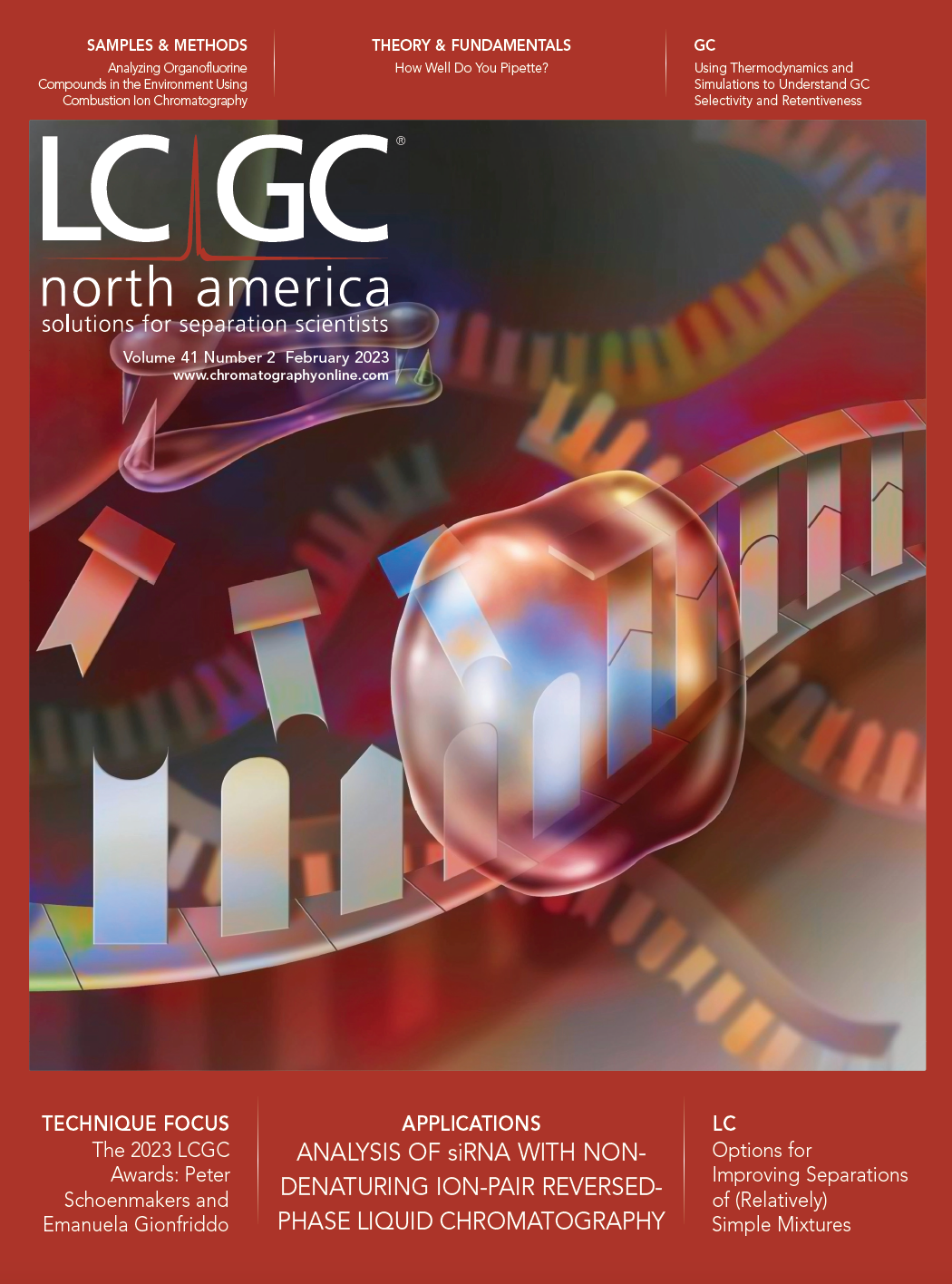Analyzing Organofluorine Compounds in the Environment Using Combustion Ion Chromatography (CIC) and Other Methods
Organofluorine compounds are potential contaminants in the environment, particularly in natural water sources. Leo W. Y. Yeung, PhD, is a Senior Lecturer in the School of Science and Technology of the Man-Technology-Environment Research Centre (MTM) at Örebro University in Örebro, Sweden. His research has involved the analysis of organofluorine compounds of concern in the natural environment. We recently spoke to him about his work using combustion ion chromatography (CIC) and other methods to analyze organofluorine and specific perfluoroalkyl and polyfluoroalkyl substances (PFAS) compounds in environmental samples.
You have studied unidentified organofluorine compounds (UOF) and extractable organofluorine (EOF) compounds in the environment (1). What concerns you the most about either the type or quantity of such contaminants in the environment, particularly natural water sources?
Both the types and quantities of unidentified organofluorine compounds are of concern. There are fewer naturally occurring organofluorines compared to the vast number of per- and polyfluoroalkyl substances (PFAS) in the global market. The proliferation of organofluorine compounds is believed to be caused by humans. The question is whether these unidentified organofluorine compounds are newly introduced to the market, or if they are the unknown intermediate compounds from degradation of precursor compounds. Precursor compounds can be related to legacy PFAS compounds, such as perfluorooctane sulfonic acid (PFOS) precursors, or pharmaceuticals or pesticides containing fluorine, with the CF3-moiety. At the same time, it is not yet known what the effects of these unknown organofluorine compounds will be to the environment or humans. Studies are being undertaken to characterize these unidentified organofluorine compounds.
What are some of the greatest challenges you have encountered for characterizing and quantifying PFAS in environmental samples?
Depending on the definition of PFAS, the number of compounds may vary from 4700 to 12,000. Regardless of which PFAS definition we use, the class includes compounds having molecular weight ranges from approximately 114 g/mol (trifluoroacetic acid) to 1204 g/mol (bis[2-[ethyl(1,1,2,2,3,3,4,4,5,5,6,6,7,7,8,8,8- heptadecafluorooctylsulfonyl)amino] ethyl] hydrogen phosphate-diSAmPAP), including side-chain fluorinated polymers, which exhibit quite different physico-chemical properties. As a result, no single extraction method can capture all PFAS and no single instrumental analysis method can analyze all PFAS. In our experience, we may need to extract the same samples using at least two extraction methods to capture polymeric and non-polymeric PFAS and use at least four instrumental methods, such as gas chromatography–mass spectrometry (GC–MS), liquid chromatography–mass spectrometry (LC–MS) (such as tandem mass spectrometry [MS/MS] and quadrupole time-of-flight mass spectrometry [QTOF-MS]), and supercritical fluid chromatography–mass spectrometry (SFC-MS) to discriminate approximately 100 PFAS compounds. It is important to note that analytical standards are only available for some 100 named PFAS compounds; thus, we may not be able to report the concentrations of some identified PFAS quantitatively because authentic reference standards are not available. In addition, as discussed above, not only are limited reference standards available, but even fewer internal standards are available for quantification to correct for recovery loss and ionization suppression in environmental samples.
What are the major theoretical and practical challenges for using combustion ion chromatography (CIC) as an analytical apparatus for EOF analysis (1–3)?
Fluorine analysis using CIC is a non-selective method, which means that you know that the sample contains fluorine, but you do not know which forms of the fluorine (organic bound or inorganic fluoride) are measured. Therefore, sample pretreatment is needed to separate inorganic fluoride from the organic bound fluorine for EOF analysis. However, different sample pretreatment, extraction methods, and washing steps may result in different amounts of EOF. Data compatibility between studies needs to be considered carefully; EOF analysis using method A may not give the same result as EOF analysis using method B. In general, the limit of quantification (LOQ) or detection (LOD) of PFAS requires analysis at the pg to sub-pg levels. Our CIC method achieves a limit of quantification/detection at ng levels. (Note: 1 picogram [pg] = 0.001 nanogram [ng]), which is 1000-fold less sensitive than that of LC–MS/MS). So samples of higher EOF concentrations are needed to achieve detectable signals from CIC.
You have published research on organofluorine analysis of whole blood samples in humans and the relation of these compounds to gender and age (4). Are these materials a concern for humans? Which groups are most affected?
The recent study was a pilot study to evaluate how much or proportion of unknown organofluorine were present in human blood. Samples were collected from different cities in Sweden where people donated their blood. Organofluorine mass balance analysis—the comparison between EOF and target PFAS—revealed that 63 monitored PFAS compounds accounted for 40% of the EOF in female samples; in males, target PFAS accounted for 59% of the EOF. Significant differences in the fraction of UOF were observed for both age groups and sex; the highest fraction of UOF was observed in young females (70% UOF, aged 18–44), which was different from observations found in other research studies for commonly monitored compounds (PFOS and so forth) where females were shown to have lower concentrations than males. However, the high fraction of UOF in human blood is of concern because we do not know the identity or sources of these unknown compounds so their potential health effects cannot be accurately evaluated.
You have investigated the presence of C1−C4 perfluoroalkyl acids (PFAAs), which are highly persistent chemicals, by studying their distribution and seasonal variation in remote Arctic locations (5). What did you learn from this work?
There are several important findings in this work. First, trifluoroacetic acid (TFA), perfluoropropanoic acid (PFPrA), perfluorobutanoic acid (PFBA), and trifluoromethane sulfonic acid (TFMS) were detected in most surface samples, including samples collected at remote locations without any potential for local sources, indicating that atmospheric transport of volatile precursors and their subsequent degradation play an important part in global distribution. Second, our results further support previously models that atmospheric concentrations of perfluorooctanoic acid (PFOA) would be 15–20 times higher in the Arctic in July compared to January, because of seasonal variations in atmospheric hydroxyl radical concentrations, which lead to degradation of 8:2 fluorotelomer alcohol (FTOH). Third, this is the first report of TFMS not only in surface snow but also at remote locations, suggesting this chemical may be globally distributed. However, further investigation is needed to understand the source and transport of TFMS to the Arctic.
What prompted you to work in the field of PFAS detection in the environment?
We have learned that there are many disturbing effects of chemicals in the environment. For example, we know of the adverse effects of dichlorodiphenyltrichloroethane (DDT), described in the book Silent Spring, or polychlorinated biphenyls (PCBs), which caused the Yusho incident. These occurrences were acute and observable. However, in the case of PFAS, their effects are not acute when compared to DDT or PCBs; more recent epidemiological studies have demonstrated a number of adverse effects of PFAS, especially on the most vulnerable groups such as children. But what we know so far is only for the known PFAS compounds. What are the environmental and health affects of unknown PFAS? Even though we may not be able to identify what they are, at least we can to determine if the levels of unknown PFAS are increasing. We are trying our best to develop different analytical methods for detecting and identifying these compounds in order to protect the environment.
What are your greatest analytical challenges for accurate and precise analysis of PFAS materials in environmental samples?
The performance of different analytical laboratories for PFAS analysis has improved a lot when compared to what we observed in 2006 (6). The improvements are attributed to a number of factors, such as availability of reference and mass labeled internal standards, standard extraction procedures, and precise standard reference materials (SRMs). However, current analytical challenges remain the same for the newly discovered PFAS. To ensure good data quality, improvements in instrumentation, data analysis, analytical reference standards, mass-labeled internal standards, extraction methods, and standard reference materials are still needed.
For you, what are the most important questions to answer or an important problem to solve related to PFAS contamination?
At the moment, several questions have to be addressed, which include: How much of PFAS are being overlooked? What are the unknowns? What is the source of these compounds? What are their effects to the environment including humans? Finally, how can we clean up PFAS contaminated areas in a cost-effective way?
What is your next area of research interest?
When one performs a literature search on PFAS, most of the research has been focusing on condensed phases (water, soil and sediment) or human exposure (internal concentration or food/water); relatively fewer investigations are available in air. It is very difficult to capture volatile PFAS in the air or to measure these aerosol compounds; therefore this area of research should be focused on more, especially when considering the destruction of PFAS by incineration, which, if not properly conducted, might produce other forms of PFAS as well as hazardous greenhouse gases. Therefore, analytical methods for measuring these volatile PFAS as well as new sampling techniques should be further developed.
References
(1) Aro, R.; Carlsson, P.; Vogelsang, C.; Kärrman, A.; Yeung, L. W. Fluorine Mass Balance Analysis of Selected Environmental Samples from Norway. Chemosphere 2021, 283, 131200. DOI: 10.1016/j.chemosphere.2021.131200
(2) Aro, R.; Eriksson, U.; Kärrman, A.; Jakobsson, K.; Yeung, L.W. Extractable Organofluorine Analysis: A Way to Screen for Elevated Per- and Polyfluoroalkyl Substance Contamination in Humans? Environ. Int. 2022, 159, 107035. DOI: 10.1016/j.envint.2021.107035
(3) Aro, R.; Eriksson, U.; Kärrman, A.; Reber, I.; Yeung, L. W. Combustion Ion Chromatography for Extractable Organofluorine Analysis. Iscience 2021, 24 (9), 02968. DOI: 10.1016/j.isci.2021.102968
(4) Aro, R.; Eriksson, U.; Karrman, A.; Yeung, L.W. Organofluorine Mass Balance Analysis of Whole Blood Samples in Relation to Gender and Age. Environ. Sci. Technol. 2021, 55 (19), 13142–13151. DOI: 10.1021/acs.est.1c04031
(5) Björnsdotter, M. K.; Hartz, W. F.; Kallenborn, R.; Ericson Jogsten, I.; Humby, J. D.; Kärrman, A.; Yeung, L. W. Levels and Seasonal Trends of C1–C4 Perfluoroalkyl Acids and the Discovery of Trifluoromethane Sulfonic Acid in Surface Snow in the Arctic. Environ. Sci. Technol. 2021, 55 (23), 15853–15861. DOI: 10.1021/acs.est.1c04776
(6) van Leeuwen, S. P. J.; Kärrman, A.; van Bavel, B.; de Boer, J.; Lindström, G. Struggle for Quality in Determination of Perfluorinated Contaminants in Environmental and Human Samples. Environ. Sci. Technol. 2006, 40, 24, 7854–7860. DOI: 10.1021/es061052c
Leo Yeung is an associate professor (docent) at the MTM Research Centre in the School of Science and Technology at Örebro University in Sweden. His current research interests are to develop analytical method on measurement of PFAS including replacement products; to apply the organofluorine mass balance approach to understand current PFAS contamination in the environment using combustion ion chromatography; to identify and measure newly identified PFAS in environmental samples using LC–TOF-MS and LC–MS/MS techniques; and to study the fate and transport of unidentified PFAS in the environment. Yeung joined the MTM Research Centre as a senior lecturer in 2016 and became an associate professor in 2018. He obtained B.Sc. (Environmental Life Science - 2003) at the University of Hong Kong, MPhil (Environmental Science - 2006) and PhD (Environmental Chemistry - 2009) at City University of Hong Kong; received post-doctoral training at City University of Hong Kong, the National Institute of Advanced Industrial Science and Technology (Japan), and University of Toronto (Canada, 2010-2014). He has also worked as a senior research associate at University of Toronto.

Jerome Workman is the Senior Technical Editor of LCGC North America. Direct correspondence to: jworkman@mjhlifesciences.com

Characterizing Plant Polysaccharides Using Size-Exclusion Chromatography
April 4th 2025With green chemistry becoming more standardized, Leena Pitkänen of Aalto University analyzed how useful size-exclusion chromatography (SEC) and asymmetric flow field-flow fractionation (AF4) could be in characterizing plant polysaccharides.










